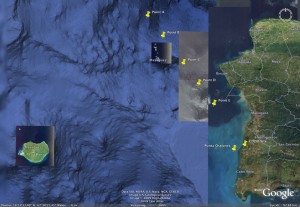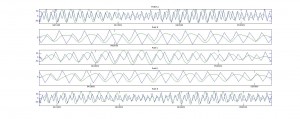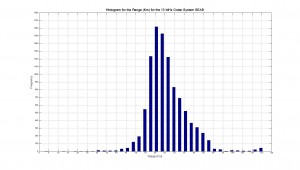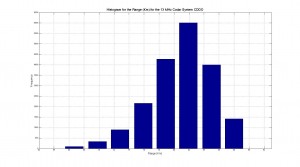-
Puerto Rico CDDO Tidal Analysis
Posted on July 6th, 2009 No commentsThis figure shows the five points selected for comparison. They are spaced at10km intervals and at a 325˚ heading from the CDDO site. They were chosen because they provide a great deal of information regarding the v (north south) component, which is the predominant flow component along the west coast of the island.
Radial data was gathered from the CDDO site in Puerto Rico for the month of April. This data was subsequently analyzed using Rich Pawlowicz’s T_Tides Matlab toolbox. The following figure illustrates the CODAR output (shown in green) for a set of five points located in the Mona channel against Punta Ostiones tidal current predictions by NOAA (shown in blue). V (north-south) current velocity component was used for comparison.
It is known that tides along the west coast of Puerto Rico are semidiurnal. However, T_tides is only calculating the diurnal component of the observed tides. This may be due the fact that T_tides is currently set to calculate only 4 Tidal constituents: O1, K1, M2, S2, which might not be the most influential constituents in this particular area of the world. Nevertheless both data sets seem to be in considerable agreement, when the semidiurnal component is ignored.It is important to note that CODAR output was initially compared with NOAA’s sea level observations at Mayaguez. This however, yielded inconclusive results.
-
Histogram of Range (Km) for the 13 MHz Codar Systems CDDO and SEAB
Posted on July 1st, 2009 No commentsThe histograms plotted were done using the radial diagnostic files from the CDDO and the SEAB 13 MHz sites. It can be appreciated from the histograms that the CDDO site has a frequency of having a larger range than the SEAB. According to the theory both sites must have similar average range values, since both of them operate at the same frequency. The difference in range between these two sites can be due to external factors such as noise interfering with the signal, lost of power, sea surface salinity, etc. The SEAB site has a range with the highest frequency value between 60 – 63 Km, while the CDDO has a 81-83 Km. The theory states that a water with a high salinity will prolong more the signal that a water with low salinity. If we look briefly at the values of salinity for CDDO ( 35 ppt) and for SEAB (32 ppt) we can expect this results. In conclusion when compare to the CDDO site with the SEAB site, it seems to be working properly, and having a good constant range.







